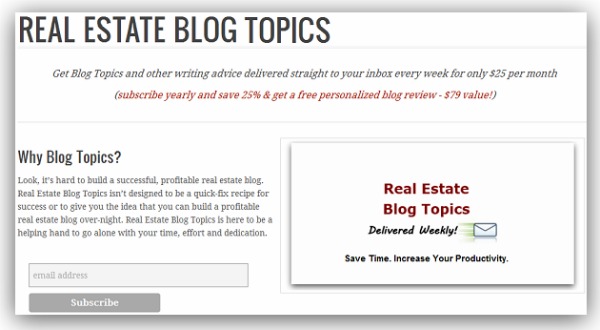I launched Real Estate Blog Topics last year. I took an idea, ran with it, and refined it along the way.
At first, it started out as a simple sales page here on my blog. Then eventually, I built a site around it and sometime in March, I’m re-launching it as a full-blown membership site consisting of a mixture of expert audio interviews, video tutorials, live Q&A’s and the content in it’s current form.
In the meantime, here’s a few of the things I’ve learned along the way…
10 Things I’ve Learned from Running a Paid Subscription:
1. Just because it’s easy to launch, doesn’t mean it’s going to be easy to maintain. Launching Real Estate Blog Topics cost me a total of $11 (for the domain name) and an idea. An idea that I’m continuously working on perfecting day after day, week after week with inspiration from folks like Thom Chambers from In Treehouses, Colin Wright from Exile Lifestyles & author of Exil.es, Adam King from the Humanity Blueprint, being a member of the Third Tribe and more.
2. Do 1 thing really well. Find one thing that you’re exceptionally good at and focus on delivering that one thing. For me, that’s helping others understand the business side of blogging and inspiring them to take action.
2. Focus on perfecting the service/product. When I first launched Real Estate Blog Topics, I was using a service called Letter.ly to manage subscriptions and payments. To their credit, Letter.ly is a great service and they made this easy. But REBT was nothing more than a landing page on my domain and a link that took people off my site and onto Letter.ly to sign up. In short, it was messy and I was losing subscribers in the process (I know because I got a few emails asking me if there was an easier way to sign up).
Today, Real Estate Blog Topics sits on it’s own domain and you get more than just an extended email weekly, content is delivered in PDF format so that you can print and/or download the content to read and learn at your leisure. The sign-up process is managed by MailChimp and Amazon Payments.
Next month, that will all change…as we become a flow-blown membership site. More on that later…
The Lesson here is to focus on delivering a valuable experience from the moment people sign-up to every interaction they have with you via email.
3. Inspire people to take action. I’ve thought about adding a membership forum for people to ask questions and engage with one another. I’ve ultimately decided against the idea for two reasons:
a.) It’s going to take time to manage. Time that I don’t necessarily have at the moment. Though I suppose I could contract someone for support in this area. At this point, I’ve received more than a handful of offers to help with something like this.
b.) It’s going to distract people from taking action. Ultimately, the goal of REBT is to inspire people to take action and implement the various strategies, tactics and ideas discussed in each issue. By adding a Q&A forum, my concern is that people are going to be distracted from that goal.
4.Don’t be afraid to set a high price. When I first launched, I set the price at $3.99 – that was a giveaway. I told myself I was “testing the market to see if there was interest.” People either jumped at it, or scoffed at the offer. Later, I raised the price to $9.99 and then again to $25 (a price I finally settled on). In doing so, I learned a few things:
- Price too low, and people won’t buy. They just don’t see the value. Some people will subscribe (everyone likes a good deal after all), but they won’t be as committed.
- It’s just as hard to sell a high priced product as it is to sell a low-priced product. Some people will always shop based on price. Somewhere along the way, I decided that those aren’t the people I want subscribing to Real Estate Blog Topics. If you see the value, your’e going to make the commitment and pay the monthly subscription. I shouldn’t have to lower my price to convince you to join. To earn subscribers, you’ll need to effectively communicate your value proposition. In other words, here’s what this is, and here’s how it’s going to help. If that clicks with your buyer, they’ll buy. If it doesn’t, they won’t but that’s ok.
- People won’t do the work if it’s too easy for them to ignore. At $3.99 it was easy for people to ignore their weekly “Action Items” – it’s a small, painless write off. At $25 per month on the other hand, it’s an investment and a commitment. A commitment from me to deliver value, consistently. And a commitment from you to do the work.
- People are willing to pay for it if they see the value. At first, I was afraid to raise the price because I wasn’t sure if people would buy. Not only did I raise the price, I also introduced a yearly subscription option that included a free personalized blog review (via video) if you signed up for the year up-front. Not only do people still continue to purchase at the current rate of $25 per month, but 3 people purchased the same day I introduced the yearly option (this was on Black Friday) and 5 people have purchased at that rate since then.
5. Strive to meet and exceed expectations. When I was subscribed to Thom Chamber’s paid newsletter (now known as The Micropublisher), he delivered a new edition every Monday morning. Most times it arrived early (often times on Sunday). On rare occasion it arrived later in the day. Anyway, it’s what I was promised when I subscribed and it’s what I came to expect. And sometimes, the anticipation ran high as I checked my inbox to see if a new edition had arrived yet.
That’s the same type of anticipation my subscribers must have in regards to a new edition of REBT hitting their inbox. Promise to deliver when you say you will. Focus on delivering high value and they’ll not only remain loyal, but they’ll tell their friends about what you have to offer (and that’s the best kind of referral you can get).
6. Do whatever it takes to make customers happy. At one time, email delivery was spotty for some of my subscribers. Emails were either getting sent to spam or not being delivered at all. I couldn’t tell whether my email address was blacklisted or if emails were simply getting caught in spam folders. In either case, I resent each edition of REBT for the week along with the latest 3 issues. I set up a new Google Apps account with a dedicated email address for Real Estate Blog Topics on it’s own domain and then proceeded to refunded charges for the month. Why? Because it was the right thing to do and I wanted to keep my subscribers happy. It’s instances like this that I can attribute a low (almost nil) cancellation rate to.
7. An email list is the fastest way to sell something. Real Estate Blog Topics is currently set up as a simple landing page and a few other common pages for navigation. There’s no blog. Which means it’s slightly harder to drive traffic to the site without paying for advertising. My solution to this was to build and utilize a mailing list. So I created a 7-part email drip campaign – The Real Estate Blogging Blueprint – as a way to capture people’s attention and up-sell them on REBT Pro (if it’s right for them of course). No hard sells. Just high value content up-front, and a “oh by the way, if you need more help, check out Real Estate Blog Topics…” To date, this has converted very well.
8. Measure everything. I know how many people I have in my email list, the open-rate for that email list, and my conversion rate any time I’ve sent a pitch email to try and get people to sign up to Real Estate Blog Topics. I know how much traffic the site is getting daily/monthly and the average conversion rate. Because I don’t have a forum built into the site, I track engagement based on email replies, and open-rates & downloads. Each weekly edition of REBT is sent via PDF that you can download from the site. On average people open each weekly email 4-6 times throughout the day and are downloading each weekly lesson.
Each of these numbers helps motivate me to set and work towards new goals. It also gives me insight into what’s working and what I could potentially improve on.
You can’t just sit there and keep hitting the refresh button to see if anyone new has purchased. You have to pro-actively measure your efforts and set goals for yourself to keep moving forward.
9. You gotta spend money to make money. I’ve spent more money on information products, ebooks and membership sites in the last six months than I ever have before. I consider it active research, training and education. Frankly, it’s nice to learn from people’s varying perspectives and then to be able to put those ideas into practice. That’s the key though, putting it into practice.
I’m also spending money on relaunching Real Estate Blog Topics Pro in the coming months (more info on that here). I’ve purchased Wishlist Member, Get Premise, and Click-Bank (which charges a one-time product activation fee) to help me turn REBT into a full-blown membership site consisting of extended video tutorials, monthly live Q&A’s, expert audio interviews and more.
Sure it cost money. But at some point, you simply outgrow what’s available to you through freemium options and it’s time to step it up. In this case, I absolutely consider it a worthwhile investment.
10. It’s hard work. Running a membership site (even a “simple” subscription) is hard work. I dedicate my Saturday mornings and Sunday evenings to writing/editing/refining each week’s edition of Real Estate Blog Topics. Sometimes, I’ll write till midnight or 1:00am on weeknights. And now that I’m re-launching and including audio, video and live Q&A’s, that means even less time for procrastination. But like I said, it’s absolutely worth the investment of time and energy.
Don’t launch something just because you think it’s “easy.” Often times, what you see is the finished product someone launched and you think, “oh wow, that looks great. They make it look so easy.” What you don’t see is the amount of hard work, time, and planning that it took to get them there.
Over to you…
Do you currently run your own membership site or paid subscription service? What lessons have you learned in the process?



